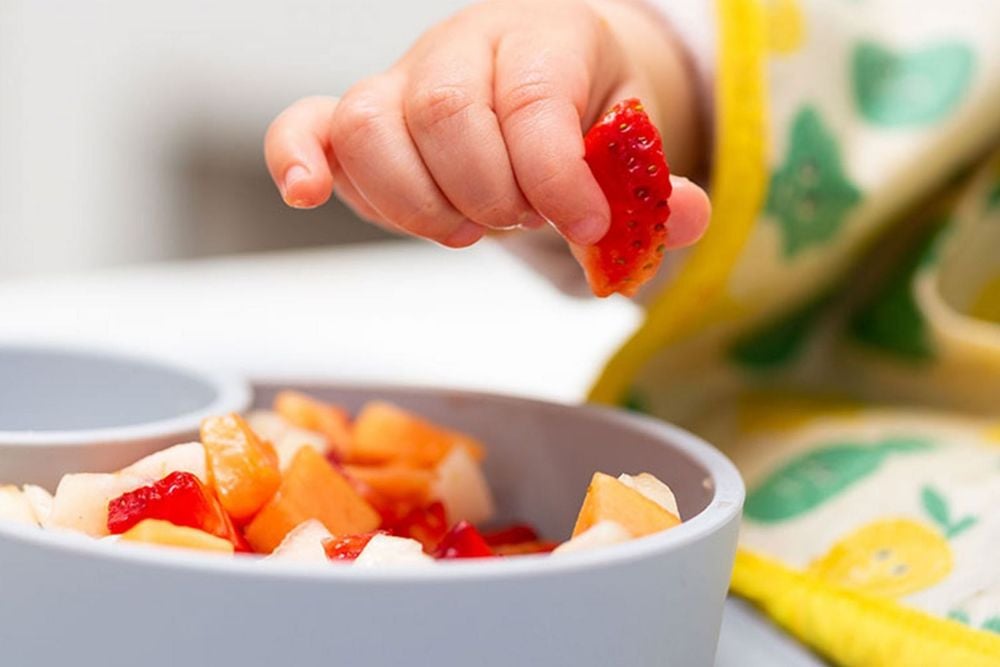This is an automatically translated article.
Starting to feed your baby can be exciting, but can be a stressful, stressful experience at times. However, if parents have knowledge about how to prepare food or choose delicious dishes for their children to eat, these will be extremely exciting culinary explorations in the first age of their child's life.1. When should you practice feeding your baby?
The ideal time to start feeding your baby really depends on the child's development, the parents' readiness, and the method of weaning that the parents have chosen.Pediatric organizations generally recommend introducing solid foods only at 6 months. Next, when the baby can sit up on his own, hold his head high and grasp, the time to start feeding is ready. By one year of age, babies can fully eat at the table with adults with age-appropriate textured foods or learn to use simple eating utensils such as spoons and forks.
How many teeth a child has or the process of baby teeth eruption has absolutely no relationship with the practice of feeding babies. Because the baby's gums have enough strength for the baby to eat and the skills of picking, chewing and swallowing are more important.
2. How to practice feeding children?
To provide foods that are safe and easy for your baby to pick up and put in their mouths, this will vary depending on your baby's age.Younger children, 6-8 months, often use their whole hands to pick up food, which means they have to close their hands around a piece of food to hold it. The food must be larger than the palm of their hand because they cannot open their fist to get it. If the food is cut into sticks, it should be about 5cm long. Giving children foods that are too small can make it difficult for them to cooperate and become irritable.
As babies get older, around 8-9 months, they can pick up smaller pieces of food thanks to their relatively complete grasping development at this age and even knowing how to use their thumbs and fingers. Point to pick up food.
Preparation of food texture is also important. Avoid making food that is too soft because when the child picks it up, it will turn into a paste. On the contrary, if it is too hard, the child will put the food in his mouth as if he cannot chew it and it can be dangerous by choking on a foreign body. Accordingly, parents should flexibly adopt different cooking methods, such as roasting, steaming, sautéing and boiling, all of which can change the texture and flavor of food. If your baby doesn't like steaming, don't be discouraged, your baby may enjoy baking as an alternative that makes the process of feeding your baby a lot of fun for the baby as well as the parents.
Besides, when feeding children fast, many parents worry and wonder if their children eat and drink enough? But instead of worrying, let your baby decide how much he or she wants to eat. Children will naturally control their own intake and will stop eating when full. At the same time, parents should allow children to eat at their own pace. It is important for parents to provide a balanced diet with easily accessible foods that will help ensure that the baby is eating the right amount of nutritious food.

Cha mẹ có thể cho trẻ ăn bốc khi tay trẻ biết cầm nắm
3. Delicious dishes for children to eat
Recipes that don't require: Cucumber: Chilled and cut into 5cm sticks. Fruit in general: Choose ripe fruit as unripe fruit is hard and can pose a choking hazard. Butter: Crush and mash or cut into cubes, sticks. Banana: Thin slices can be slippery and difficult for babies to pick up. Break into large chunks or leave some peels as “handles”. Berries (blueberries, raspberries, strawberries,...): All good for babies. The fruit can be cut into half if the size is large. Round fruit like grapes, cherry tomatoes: Cut in half lengthwise or into quarters. Kiwi, mango, melon, pineapple, pear: Diced, cut into bite-sized pieces. Items to be prepared: Asparagus: Steamed/grilled and cut into bite-sized pieces. Beets, broccoli, carrots, potatoes, squash: Steam and cut into bite-sized pieces. Eggs: Boiled and peeled, quartered or fried and chopped. Mushrooms: Stir-fry and cut into bite-sized pieces. Apples, pears: Bake or sauté until tender. Cut into pieces of the right size. Chicken: All sliced, grilled/pan-fried/boiled, shredded or diced. Fish: Grill/pan-fry fish fillets, carefully scale and remove bones before serving Ground meat (beef, chicken, pork, lamb or turkey): Stir-fry until fully cooked whole, add herbs and spices for extra flavor. Roll the ball into a round block. Pasta: Boil, cook and serve with sauce. Shrimp: Peel, devein and cook completely. Small shrimp can be given to children to hold whole. Large shrimp cut into small pieces of suitable size. Rice: Cooked into soft rice and rolled into balls Toast: Finger-cut or chopped, spread with some cheese, butter or peanut butter. Dishes to prepare: Bean pancakes Fried sweet potatoes Pizza Salty muffins Salted waffles Chicken balls Egg rolls
Trái cây mền là loại thực phẩm thích hợp cho trẻ ăn bốc
4. Types of food to be careful when feeding children
When feeding young children, caregivers should pay attention to the following processing:Whole nuts or large nuts: Avoid eating until the child is fully conscious because of the high risk of choking, They can get stuck in the baby's windpipe and cause suffocation. Popcorn: Avoid unopened nuts in general, as they can also get stuck in your baby's throat and block the airways. Honey: Absolutely do not give honey to children under 12 months, because it may contain Clostridium botulinum spores, leading to botulism poisoning. Round fruits: Beware of round fruits like grapes and cherry tomatoes. Children should be fed only when cut in half lengthwise or in quarters. Fish: Pay attention to remove all bones before feeding to children. Avoid deep-sea fish, which can contain high levels of heavy metals. Meat: Take care to remove the bones in the meat. Processed foods: Be careful and avoid if possible. Processed foods are often too high in sodium for young children. Salt: Be careful and avoid if possible, infants under 1 year of age should not eat more than 1g salt 0.4g sodium per day. Do not add salt to your child's food. Sugar: Be careful and avoid if possible, sugar provides empty calories without nutrients as well as damaging children's teeth. Foods that cause "sticky": Avoid candy or jelly as they can get stuck in the child's throat. Be careful with butter and cheese as they can make it difficult for children to swallow. It is advisable to spread thinly on bread before giving it to children. Hard foods: Avoid hard foods like raw carrots and apples because biting can cause the knots to break and pose a choking hazard. Children should be eaten soft by cooking. In short, learning to feed babies is a memorable experience for not only children but also parents. With the above suggested dishes and diverse processing skills, each meal of the child will definitely be as exciting as a learning and discovery session, providing adequate nutrients for children and building skills. feeding skills for children in the next stage of life.
For children to be healthy and develop well, it is necessary to have a nutritious diet in terms of quantity and quality balance. If children are not provided with adequate and balanced nutrients, it will lead to diseases of excess or lack of nutrients, which adversely affect the comprehensive development of children in terms of physical, mental and motor skills.
Children who do not eat properly are at risk of micro-mineral deficiency causing anorexia, growth retardation, malabsorption,... If they notice the above signs, parents should supplement their children with products. The supplement contains lysine, essential micro-minerals and vitamins such as zinc, chromium, selenium, and B vitamins to help fully meet the nutritional needs of children. At the same time, these essential vitamins also support digestion, enhance nutrient absorption, help improve anorexia, and help children eat well.
Parents can learn more:
Signs of zinc deficiency in children
Micronutrient deficiency and failure to gain weight in children
For more nutritional knowledge and child care for each age, parents please regularly visit the website vimec.com and make appointments with the leading doctors, pediatric specialists - nutritionists of Vinmec International General Hospital when needing advice on children's health.













